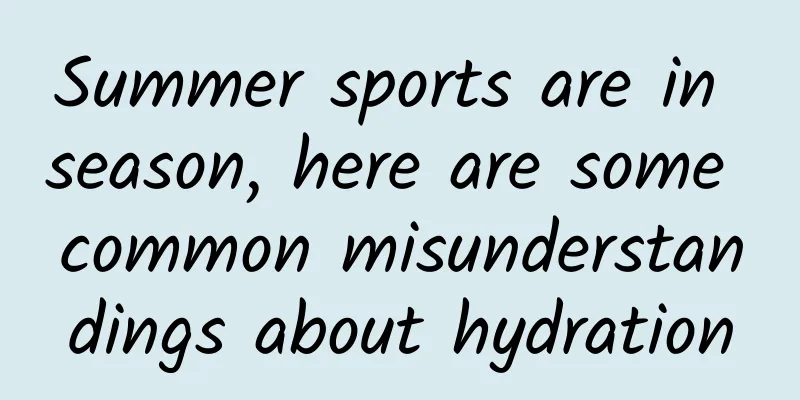Summer sports are in season, here are some common misunderstandings about hydration

|
Grain in Ear has passed, the summer solstice is approaching The scorching sun can't stop the passion for sports While sweating profusely Please don't forget to hydrate your body scientifically Why should we replenish water? Sweat is the "air conditioner" of our body. When we exercise, blood circulation speeds up, body temperature rises, and the body dissipates heat through sweating to lower the surface temperature. Moderate to high intensity exercise can produce 0.5 to 2.0 liters of sweat per hour, and the amount of sweat is even greater in a hot and humid environment. Proper water intake helps improve physical function and exercise performance, maintain a constant body temperature, and promote the recovery of human physiological functions. If water is not replenished in time, water loss during exercise will not only damage health, but in severe cases, it may threaten life safety. Are you among the misconceptions about hydration during exercise? Myth 1: Drink water only when you are thirsty Some people judge their dehydration by whether they feel thirsty during exercise. However, in a hot environment and during intense exercise, thirst is no longer a reliable signal from the body. When you feel thirsty, it means that your body is already in a state of mild dehydration, and your exercise function and endurance have begun to decline. Correct approach: During exercise, you should replenish water every 15 to 30 minutes, 150 to 300 ml each time. Under normal circumstances, the amount of water replenished per hour should not exceed 1000 ml. Myth 2: Drinking all at once Many people drink water violently during exercise, with the ambition of "drinking 300 cups". However, a large amount of blood flows into the muscles during exercise, and the blood supply to the digestive system is temporarily reduced. At this time, a large amount of water intake will cause water accumulation in the gastrointestinal tract, affecting gastric emptying, and may cause symptoms such as gastric traction pain. At the same time, a large amount of water will increase the circulating blood volume, increase the burden on the heart, and affect the rest and recovery of organs after exercise. Correct way: Drink water slowly in small sips, preferably in small amounts and multiple times. Myth 3: Drink only boiled water For moderate-intensity or less exercise, if the exercise time is less than 1 hour and the amount of sweating is not much, drinking boiled water can achieve the purpose of hydration. When the exercise lasts for more than 1 hour, and the intensity is high and the amount of sweating is large, the body will lose more electrolytes such as sodium and potassium while sweating, leading to electrolyte disorders in the plasma, which may eventually lead to hyponatremia, cramps, etc., and also increase the risk of muscle strain. At this time, you need to drink an appropriate amount of sports drinks or homemade electrolyte water (it is recommended to supplement water containing 0.2-0.4 grams of sodium salt and 5-8 grams of sugar per 100 ml) to help the body return to a state of balance. Correct approach: Determine whether you need to drink sports drinks based on the amount of exercise, duration of exercise, and amount of sweating What is the scientific way to replenish water during exercise? Before exercise: It is recommended to drink 400-600 ml of water 2 hours before exercise, and then drink about 300 ml of water 2-3 times in the first 15 minutes. During exercise: It is recommended to replenish water every 15 to 30 minutes, 150 to 300 ml each time, and the amount of water replenished per hour should not exceed 1000 ml. After exercise: It is recommended to determine the amount of water to drink by measuring the change in weight before and after exercise. For every kilogram of weight loss, replenish 1.0 to 1.5 liters of water. |
<<: Beware! Insomnia may also be a disease
>>: Pay attention to scoliosis and help children avoid taking a detour
Recommend
Body mass index calculation formula for girls
Female hypotension mostly occurs in young women, ...
What are estrogen analogs?
What are estrogen analogs? Estrogen is actually a...
What to do if the eyelash curler doesn’t curl?
If your eyelash curler doesn't curl, you can ...
How to get rid of aunt acne
In fact, what most women don’t know is that menst...
Why don't I have my period after IUD removal?
Some couples who don't want children after ge...
White granular substance on areola
It is common to have white granular substances on...
What to do if leucorrhea is like egg white
Whether our female bodies are healthy or not is o...
Can a girl get pregnant if she has stomach pain? Let you know the real situation
Some women experience the worst pain in their sto...
Can I eat hot pot when I am pregnant?
When it comes to hotpot, everyone must be familia...
Are small bumps on a woman's private parts condyloma acuminatum?
When a woman has small bumps on her vaginal openi...
Will the first induced abortion affect pregnancy?
Induced labor is different from abortion. Induced...
I was diagnosed with cancer at the age of 25, but I didn't take it seriously because I had symptoms two years ago! These "words" in the medical examination report are dangerous!
Many people schedule a physical examination for t...
How many menstrual periods are normal in a year?
We all know that when women enter puberty, becaus...
University of Vermont: Twitter word survey shows we are not as happy as before
On December 21, 2011, scientists from the Univers...
Steps for washing hair with ginger water during confinement
Washing your hair during the confinement period i...









